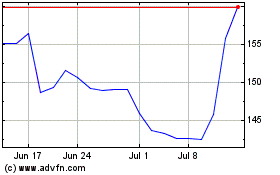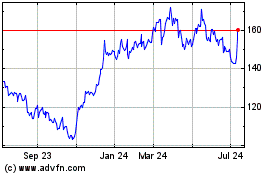Lennar, CalAtlantic Strike Deal to Create Largest U.S. Home Builder -- 4th Update
October 30 2017 - 6:03PM
Dow Jones News
By Chris Kirkham and Laura Kusisto
Lennar Corp. agreed to buy CalAtlantic Group Inc. for $5.7
billion, creating the country's largest home builder by revenue in
the latest affirmation of a U.S. economic expansion now in its
ninth year.
The proposal marks the largest merger of home builders since the
financial crisis, a milestone for the recovery of an industry that
was hard hit by the housing collapse last decade but has
contributed significantly to U.S. growth in recent years.
The deal would create a combined company with revenues of more
than $17 billion as of last year and a market cap of roughly $18
billion, based on Friday's closing share prices.
Major home builders are looking to control rising costs for
land, labor and materials as the U.S. housing market expansion
continues. Builders increasingly are focusing on first-time home
buyers purchasing less-expensive homes, which has put pressure on
profit margins.
Lennar Chief Executive Stuart Miller said the combination will
increase Lennar's presence in markets it already operates in and
allow it to be one of the top three home builders in 24 of the top
30 markets in the country.
On a conference call Monday, Lennar executives pointed out that
the two companies are already competing in many of the same
markets. With more scale, they said they can lower costs by
negotiating better deals with construction crews and suppliers.
"It should be no surprise that the more you buy, the less you
pay," said Lennar President Rick Beckwitt.
The companies expect the deal to generate $250 million in annual
cost savings by the 2019 fiscal year, and roughly $75 million in
fiscal 2018.
In acquiring CalAtlantic, Lennar will have access to a new
supply of developable land that can be built on quickly, which is
less risky than buying large tracts of undeveloped land that could
take years to get permits.
Analysts agree that a larger company will better be able to
navigate increasing construction costs, which have outpaced price
increases of new homes every quarter over the past three years,
according to data from John Burns Real Estate Consulting, which
tracks the industry.
Facing construction-labor shortages in many markets, builders
have to compete for the best crews. More scale means more steady
work for construction crews, which analysts said would give the
combined company an advantage in negotiations.
"The bigger you are, certainly the better-positioned you are in
that market," said Credit Suisse home building analyst Susan
Maklari. "You can say 'It's not worth leaving me and going to
another builder's site.'"
CalAtlantic itself was the product of a 2015 merger between two
other major home builders, Standard Pacific Corp. and Ryland Group
Inc.
Home builders struggled through the 2007-09 recession and the
early economic recovery as millions of Americans faced foreclosures
and unemployment. Single-family home construction has only recently
begun to surpass the prior 30-year average, but home builders over
the past year have reported a return of first-time buyers to the
market as economic conditions improve.
"We are starting to see an enabled home buyer, a home buyer that
is witnessing wage growth, and a mortgage market that is accepting
of home buyers coming back to market," said Lennar Chief Executive
Stuart Miller on a conference call about the deal on Monday.
The homeownership rate hit 63.7% in the second quarter, a jump
of nearly a full percentage point from a year earlier, according to
the Census Bureau. Younger households helped drive that
improvement: The homeownership rate for households headed by
someone under 35 years old jumped to 35.3% from 34.1% a year
earlier.
Still, these households are particularly price-sensitive,
placing additional pressure on builders to control costs and keep
the price of these homes at a level first-time buyers can afford.
Data in recent months has indicated a pull-back in first-time buyer
activity as prices have rise and inventory remains tight. New home
sales had their largest single-month increase since 1992 in
September, a sign of forward momentum in the market.
More home buyers means more sales for home builders, but it is
difficult to maintain the same kind of profit margins generated by
high-end luxury home sales that dominated the early years of the
economic recovery. Both Lennar and CalAtlantic have among the
highest gross profit margins in the industry, and Lennar executives
said they expect gross margins to remain above 22% following the
acquisition.
CalAtlantic shareholders will also have the option to exchange
all or a portion of their shares for cash, subject to a maximum
cash amount of $1.2 billion, or about 27% of CalAtlantic's market
value.
The deal is subject to approval by shareholders of both
companies, and is expected to close early next year.
CalAtlantic shares, up 42% since the beginning of the year,
closed Monday up 21%. Lennar shares were down 4% on the news.
--Cara Lombardo contributed to this article.
Write to Chris Kirkham at chris.kirkham@wsj.com and Laura
Kusisto at laura.kusisto@wsj.com
(END) Dow Jones Newswires
October 30, 2017 17:48 ET (21:48 GMT)
Copyright (c) 2017 Dow Jones & Company, Inc.
Lennar (NYSE:LEN)
Historical Stock Chart
From Mar 2024 to Apr 2024

Lennar (NYSE:LEN)
Historical Stock Chart
From Apr 2023 to Apr 2024
